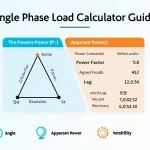Voltage Calculator
Is this tool helpful?
How to use the tool
- Fill “Current (A)” with the flowing current. Example entries: 2.20 A or 0.12 A.
- Fill “Resistance (Ω)” with the load resistance. Sample values: 33 Ω or 220 Ω.
- Press the calculate control—your browser multiplies the two numbers.
- Read the output labelled in volts (V).
Formula behind the scenes
Ohm’s Law links the three variables:
$$V = I \times R$$- V – voltage in volts (V)
- I – current in amperes (A)
- R – resistance in ohms (Ω)
Checked example 1
- I = 2.20 A
- R = 33 Ω
- $$V = 2.20 \times 33 = 72.6\;V$$
Checked example 2
- I = 0.12 A
- R = 220 Ω
- $$V = 0.12 \times 220 = 26.4\;V$$
Quick-Facts
- IEC standard nominal voltages: 120 V & 230 V worldwide (IEC 60038, 2016).
- Safe-touch limit: 50 V DC or lower reduces shock risk (NIOSH, 2020).
- Common resistor values range from 1 Ω to 10 MΩ (EIA Standard RS-196E, 2015).
- Copper’s resistance rises 0.393 % per °C (NIST Datasheet, 2023).
FAQ
What equation does the Voltage Calculator use?
The calculator multiplies current by resistance according to Ohm’s Law, $$V = I \times R$$ (Ohm, 1827).
Can I enter decimal numbers?
Yes. The form accepts decimals such as 0.12 A or 47.5 Ω, reflecting instrument readings (Keysight Application Note, 2021).
How accurate is the displayed voltage?
The arithmetic is exact; overall accuracy depends on the tolerance of your current and resistance measurements, typically ±1 % for lab DMMs (Fluke Datasheet 87V, 2022).
Does the tool work for AC circuits?
It handles AC only when you use RMS current and pure resistance; reactive components require impedance, not simple resistance (IEEE Std 141-1993).
What is a safe voltage to touch?
Regulators label 50 V DC or 30 V AC RMS as the threshold above which shock hazards increase (NIOSH, 2020).
How do I find current if voltage is known?
Rearrange Ohm’s Law to $$I = rac{V}{R}$$ and divide voltage by resistance—use a current calculator for convenience (Horowitz & Hill, 2015).
What happens if resistance is zero?
Zero resistance causes the calculated voltage to be zero, but in practice it implies a short circuit where current rises only limited by the source impedance (IEEE Std 242-2001).
Why does temperature change resistance?
Metals have more lattice vibrations at higher temperatures, increasing electron scattering and resistance—approximately 0.4 % per °C for copper (NIST Datasheet, 2023).
Important Disclaimer
The calculations, results, and content provided by our tools are not guaranteed to be accurate, complete, or reliable. Users are responsible for verifying and interpreting the results. Our content and tools may contain errors, biases, or inconsistencies. Do not enter personal data, sensitive information, or personally identifiable information in our web forms or tools. Such data entry violates our terms of service and may result in unauthorized disclosure to third parties. We reserve the right to save inputs and outputs from our tools for the purposes of error debugging, bias identification, and performance improvement. External companies providing AI models used in our tools may also save and process data in accordance with their own policies. By using our tools, you consent to this data collection and processing. We reserve the right to limit the usage of our tools based on current usability factors.







